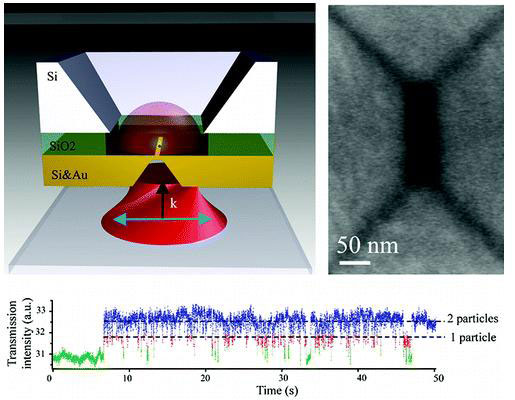| Mar 15, 2012 |
New technique to detect and manipulate nano-objects using plasmonic nano-cavities
|
|
(Nanowerk News) Imec researchers have presented a new approach to detect and manipulate nano-objects (see paper in Nano Letters: "Enhanced Optical Trapping and Arrangement of Nano-Objects in a Plasmonic Nanocavity"). The technique makes use of plasmonic excitation in nanocavities. In a demonstration, a rectangular nanocavity was used to detect the presence of 22nm beads. This approach may open new routes to create optical tweezers at the nanoscale, for ultra-accurate sensing, trapping, and arranging of nanoscale objects, such as biomolecules (e.g. proteins or DNA).
|
 |
| SIBA plasmonic trapping using a Fabry–Pérot nanopore cavity.
|
|
Optical trapping techniques, the so called optical tweezers, are used to trap and manipulate objects. A highly focused laser beam provides an attractive or repulsive force to physically hold and move microscopic dielectric objects (down to micrometer-scale). But this technique cannot be applied straightforward to nanoscale objects. The energy required to manipulate such small objects is simply too large in relation to their size and would destroy the objects. Recently, researchers have therefore come up with the idea to make use of the strong local fields of metal nanostructures that are excited by light.
|
|
When metal nanostructures are illuminated with visible to near-infrared light, strong local electromagnetic fields are generated. These are caused by the collective oscillations of conduction electrons – called surface plasmons. These fields can be detected and visualized e.g. through surface-enhanced Raman spectroscopy. And because the presence of nanosized objects, such as biomulecules, causes changes in the fields, this phenomenon can be used as a sensor.
|
|
But the energy of the local fields could also be used to trap and manipulate the nanosized objects. In a recent publication, imec's researchers now present a new approach that uses this technique. They combine self-induced back action (SIBA) trapping with the latest advances in nanoscale plasmon engineering.
|
|
As a demonstration, the researchers designed a resonant trap in the form of a rectangular nanopore. This form of pore allows for tuning the plamons by changing the aspect ratio. This trap was successfully tested with 22nm polystyrene beads, distinguishing between events where one bead was trapped, or those where two beads were trapped at the same time. As part of their work, the researchers also proposed a figure of merit to quantify the efficiency of their trapping mechanism and to compare it to other optical nanotweezers.
|
|
|

